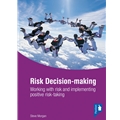Working with Risk Tools
 Sunday, November 14, 2010 at 11:24PM
Sunday, November 14, 2010 at 11:24PM Risk assessment, risk management and risk-taking are essential elements of mental health practice. However, focus has progressively moved away from clinical judgement towards the administrative requirements of form filling. Practical tools should firstly offer a guide to practice, and secondly the user-friendly format for recording the information and plans that arise. 'Working with Risk' is a flexible package of tools designed to support clinical practice. It offers ideas for three different stages of risk assessment, risk management and risk-taking. These are designed to support the clinical judgement of individual practitioners and teams. These can be used individually as stand-alone tools, or collectively as a whole package.
For services wishing support to implement the flexible set of Working with Risk tools, contact me for negotiating Consultancy services including developing a 'Risk Management Policy' supporting a positive risk-taking approach.
 The 'Working with Risk' tools located above have been developed into a 2-day Risk Trainers Manual and an accompanying Practitioner Risk Manual and were published by Pavilion Publishing in Spring 2007. The article below, written by Steve, gives an overview of the tools. It was first published in Mental Health Today in September 2007 and included here with their kind permission.
The 'Working with Risk' tools located above have been developed into a 2-day Risk Trainers Manual and an accompanying Practitioner Risk Manual and were published by Pavilion Publishing in Spring 2007. The article below, written by Steve, gives an overview of the tools. It was first published in Mental Health Today in September 2007 and included here with their kind permission.
Article: Working with Risk: Steve Morgan outlines a new training pack on positive risk management.
 risk in
risk in  Positive risk-taking
Positive risk-taking 







